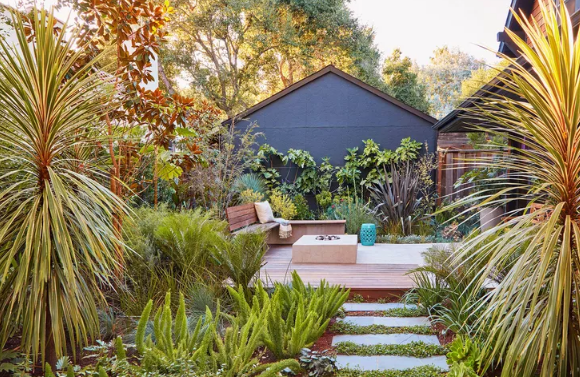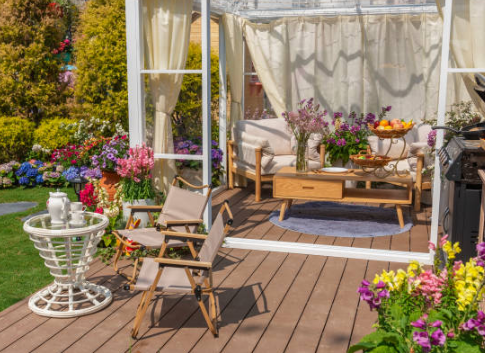A freestanding terrace can add a splash of color to your home’s backyard landscape. This patio structure is self-supporting and does not connect directly to your home. It is often the most practical option for houses with brick or stucco facades, as brick or plaster can make it difficult to install classification panels. Detached terraces can also be placed away from the house as a prominent feature, or built around the pool.
As a place to create new family memories and entertain numerous guests, a freestanding terrace is something you’ll want to use for a long time. If you’re planning to build one yourself, it’s important to know the special considerations for supporting and building freestanding structures. With basic construction knowledge, you and your assistant can easily complete these steps. It’s not a project that can be completed in one afternoon, but when all is done, you’ll have a stunning freestanding terrace. Refer to this guide on how to build a freestanding patio for everything you need to know about this exterior project.

The Type of Timber for the Freestanding Deck
Pressure-treated timber is often the most cost-effective option, both for the visible part of the freestanding deck and for structural elements. However, without proper care, decks made of pressure-treated wood can lose their appearance: the wood is prone to bending, cracking, and turning an unsightly gray. But with a little care, a treated wooden deck can stay beautiful for many years. First, choose planks that are straight, dry, and free of large knots. Pressure-treated wood can twist and bend as it dries, so stack it tightly before installing it and holding it securely. After about a month, check if any fasteners are loose. If there is, remove it and install longer fasteners.
Other types of deck timber include naturally resistant species such as cedar and mahogany, which are more expensive but resistant to rot and insects. Imported timbers such as heavy antwood and composite deck materials are more durable, but they are also more expensive and often difficult to process.
Arrange the Freestanding Deck
The first step in building a freestanding terrace is to plan the location of the terrace. You can build the patio next to your home so it can function like an attached patio, or you can choose a location further in the yard. When laying out free-standing terraces, keel slabs are built as foundations. These temporary columns will help ensure precise lines and corners. Then, pull out a grid along the columns to measure the boundaries of the future terrace. Once you’re done with everything, you’re ready to head to the hardware store to buy the materials you need to build your patio.
Freestanding Deck Foundation
Your terrace is beautiful from above, but what’s below is what matters. Once you’ve sized your deck, you’re ready to start laying the foundation and laying protective barriers. The foundation will provide a solid, secure foundation for your freestanding terrace, while the multi-layered cladding and rocks underneath the terrace will hinder the growth of weeds. For each foundation, you need to dig a post hole, fill it smoothly with concrete, and check for air bubbles. Then rake 1 to 2 inches of gravel over the surface area that the patio will cover.
If you are building a freestanding terrace next to your house, keep in mind that the soil near the foundation of your new house (the soil that backfills after pouring the concrete basement) is unstable. Local regulations generally require that a concrete foundation within 3 feet of the foundation must be 8 feet deep. To avoid spending time, effort, and money on building such a deep foundation, you can instead use heavy-duty beams that are placed on a foundation that is further away from the house. The beams made of 2×10 are perpendicular to the house and are strong enough to cantilever, 3 feet, beyond the foundation. The middle beam supports the two terrace levels.

Freestanding Deck Beams, Beams and Joists
Sturdy beams are essential for your freestanding deck. To make your deck surface as safe as possible, we recommend using a beam made of three 2×10-inch planks. This can take longer than the traditional technique of using a large solid beam, but it is usually easier to install correctly. Don’t cut corners on this step, as the beams support the joists that support the deck planks. Providing a safe place for your family depends on your attentive work.
Once the sturdy beams have been constructed, it is time to start installing the beams, beams, and external joists. A frame plan will help you properly lay out and measure your joists and allow you to plan out details such as the length of the beam. You’ll need a right-hand man to complete this installation. Together, you’ll level the beams, cut the beam joists, and lift the entire frame onto the set beams. Once you’re done, you’ll be able to see the freestanding deck assembled complete.
The interior joists support the deck’s surface planks. It is important that these planks are level, precisely spaced and, most importantly, sturdy. In this step, you’ll first measure and cut the joists. Blocking techniques are then used to prevent the joists from bending. With such a sturdy foundation, your deck can serve as the foundation for interesting family memories for years to come.
Other Independent Deck Ideas
For a classic, uniform look, consider laying floors at a 45-degree angle, which is an achievable project for DIY homeowners. After measuring and cutting the planks with an electric miter saw, you will nail in the joists and attach the planks. Chalk lines will help you cut the edges to perfection for a smooth, crisp surface.
Complete your freestanding terrace by building a set of stairs. Just like your patio, stairs need foundations, which are then paved with planks. Use the skills you’ve already learned to build a sturdy staircase. To add the finishing touch (and add security), you can also build a short handrail, although this is usually not necessary.

